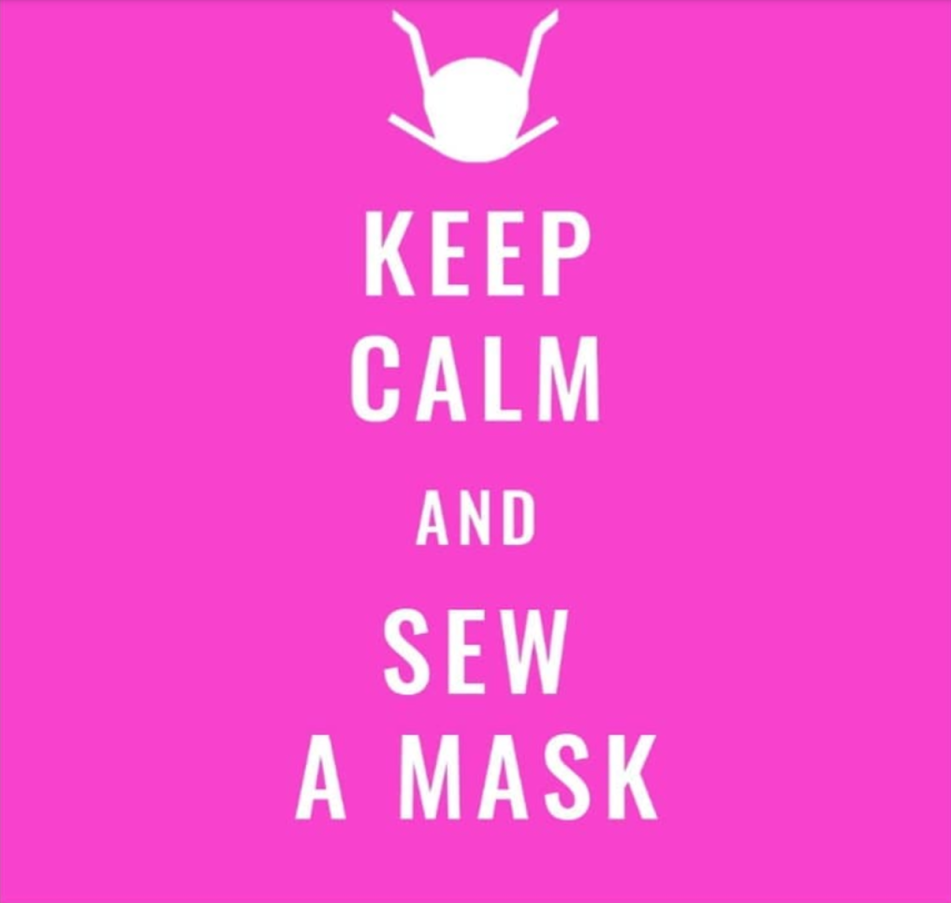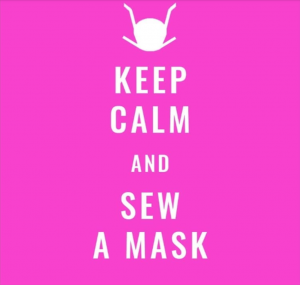
When life seems particularly unpredictable and scary, I find it tremendously helpful when I can identify something productive to do – and doubly so when it will potentially benefit not only me and my family, but our community as well. Anyone watching the news lately will be aware of the shortage of face masks for health care providers on the frontlines of this pandemic, as well as for everyday people who are at risk of either spreading or contracting the Coronavirus/Covid-19.

While the face masks we sew at home may not meet the CDC guidelines for medical professionals, it is my understanding that depending on the design, cloth masks can be used in conjuntion with the N95 medical grade masks, acting as a removable cover that can extend the usable lifespan of the medical grade mask underneath. When the medical grade masks are not available, they can be used by themselves to offer at least some protection.
Cloth masks may also be in high demand from local hospitals, nursing homes, cancer-related organizations, or other health care facilities.
Please note that I am not a medical professional. But as I understand it, by themselves, fabric masks will not completely prevent the spread of the Coronavirus or Covid-19. However, they can help us keep our germs to ourselves; and hopefully, slow the spread of the disease. A mask can also help remind the wearer to avoid touching their face. 🙂
I’m including a link to the guidelines from the World Health Organization for when and how to properly use face masks. They suggest masks for those who as sick and for those who are caring for the sick.
UPDATE from the CDC: “CDC recommends wearing cloth face coverings in public settings where other social distancing measures are difficult to maintain, such as grocery stores, pharmacies, and gas stations. Cloth face coverings may slow the spread of the virus and help people who may have the virus and do not know it from transmitting it to others…. While people who are sick or know that they have COVID-19 should isolate at home, COVID-19 can be spread by people who do not have symptoms and do not know that they are infected. That’s why it’s important for everyone to practice social distancing (staying at least 6 feet away from other people) and wear cloth face coverings in public settings. Cloth face coverings provide an extra layer to help prevent the respiratory droplets from traveling in the air and onto other people.”
And here some of the free patterns and tutorials I’ve collected from around the web that I feel are particularly helpful:
- Sew it Online – How to Sew a Face Mask for Hospitals – downloadable/printable PDF pattern and video tutorial
UPDATE 3/30/2020 – Although I recommend this pattern, I do want to correct the mistaken impression that medical professionals (or anyone else, for that matter) can flip the mask over and use the other side after the mask has already been in use. Do not do this!!!
- From Instructables – A. B. Mask – For a Nurse, by a Nurse (Jessica Nandino) – photo tutorial and printable template
- From Deaconess Hospital – How to Make a Face Mask – printable PDF pattern and video
- From Missouri Star Quilt Company – How to make an easy face mask that’s washable and reusable with spare fabric – video tutorial
- Button Counter – Facemask: A Photo Tutorial – step-by-step photo tutorial (this one was originally posted for dealing with allergies, but it might be easier to follow for people who are visual learners)
- CraftPassion Face Mask Sewing Pattern – includes free files for CriCut and Silhouette Cutter users. (This link was also posted on the JoAnn Fabrics & Crafts – Make to Give page about making face masks.)
I’m sure there are many, many other great patterns and tutorials floating around; but these links provide a good starting place.
How do we get these masks to those who need them?
That will depend on where you live. I would start with contacting your local hospitals and doctor’s offices, as many around the country (and the world!) have already put out calls for donations. In the US, all open JoAnn Fabrics & Craft stores will serve as collection points, as well as many local quilt shops and sewing centers. My recommendation is to always call ahead to see if there is a need and determine if there is a set drop-off point.
Stay safe, everyone & let’s all do our part!
I have a nurse neighbor who is snatching up my masks as fast as I can make them. The sources are running out of elastic. Until the huge roll I ordered comes, I will be attaching ties. The ties make for a mask that can be laundered in hotter water with chlorine bleach.
Good point, Sally! As of this morning, my usual sources were also out of elastic, so I’m switching to fabric ties as well. I’m so glad your neighbor is able to use the masks! And many thanks to you for making them 🙂